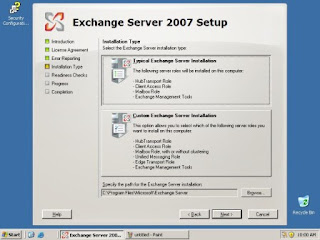
Click Next and you will see the screen shown in Figure 3. This screen asks you if you want to perform a typical or custom Exchange Server installation. While asking about custom installations isn't new to Microsoft products, the way that Exchange Server 2007 goes about the process is new.
Notice that there are a number of Exchange Server 2007 server roles listed below each installation type. Server roles are a big new concept in Exchange Server 2007. The roles that you select control the server's capabilities and what services and dependencies are installed. I will be talking a lot more about roles in future articles. For now though, select the "Typical" Exchange Server Installation option and then click Next.
Enter a name for the Exchange Server organization and click Next. The default organization name is "First Organization," which is what I will be using for the purposes of this tutorial. In Exchange Server 2003, choosing an organization name was a big deal because it could not be changed later on. I'm honestly not sure if this has changed in Exchange 2007 or not, but choose your name carefully just in case.
Click Next and Setup will ask you if you have any client computers running Outlook 2003 or earlier versions of Microsoft Outlook. When answering this question, think about not only if there are Outlook 2003 clients now, but whether there will ever be any Outlook 2003 clients. Since I am using Outlook 2007 on a test network, I answered "No" to this question.
Notice that there are a number of Exchange Server 2007 server roles listed below each installation type. Server roles are a big new concept in Exchange Server 2007. The roles that you select control the server's capabilities and what services and dependencies are installed. I will be talking a lot more about roles in future articles. For now though, select the "Typical" Exchange Server Installation option and then click Next.
Enter a name for the Exchange Server organization and click Next. The default organization name is "First Organization," which is what I will be using for the purposes of this tutorial. In Exchange Server 2003, choosing an organization name was a big deal because it could not be changed later on. I'm honestly not sure if this has changed in Exchange 2007 or not, but choose your name carefully just in case.
Click Next and Setup will ask you if you have any client computers running Outlook 2003 or earlier versions of Microsoft Outlook. When answering this question, think about not only if there are Outlook 2003 clients now, but whether there will ever be any Outlook 2003 clients. Since I am using Outlook 2007 on a test network, I answered "No" to this question.